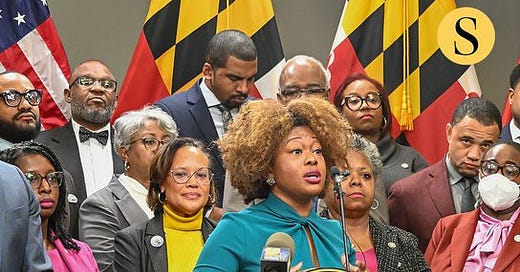Maryland Governor Wes Moore vetoed legislation to study reparations for American slavery. https://www.nytimes.com/2025/05/18/us/maryland-governor-vetoes-reparations-bill.html https://thehill.com/homenews/state-watch/5307282-maryland-governor-wes-moore-reparations-bill/ I could not be happier. Over the course of thirty essays, I have laid out the multi-layered case against reparations for American slavery. Do I credit logic for Governor Moore’s wise veto? I wish I could. Do I credit principle for the thumbs down? That would be nice but probably gives ethics and morality too much credit. I believe the vibe has shifted in the country and the world this year. I credit The Fourth Turning.
People are fatigued with the lack of accountability in the realm of race. The white guilt card has been overplayed. As I plainly put it to Klingon, if my Grandma born in 1893 did not clamor for reparations for American slavery, why would able-bodied men and women thirst for reparations in the year 2025? It is embarrassing, the utter lack of self-respect.
Even former slaves pulled their pants up and got about the business of enterprise and property accumulation. My Grandma’s Grandfather, Daniel Brown, was born a slave in Charlotte County, Virginia in 1833. Was he crippled by his slave status? Did he lust for reparations before he could provide for his family and descendants? The records reveal that Daniel Brown purchased his first property in 1869 and he did not stop until he had acquired over 500 acres of land in Chesterfield and Charlotte Counties, Virginia.
When Daniel died, he did not leave his grieving widow with a bill. He left his beloved with a will. The following is a partial listing of resources Sally Anne Brown could draw upon in her sorrow and as the mother of ten black children in 1885:
One brown mule — Bill
One dun mule — Tom
One black mule — George
One bay mare — Kate
One bay mare — Dolly
One Buffalo Cow
One Red Cow
One Yearling
Six (6) hogs
Six (6) pigs
Three (3) sheep
Fifteen (15) Fowls
Three (3) Wagons
Two (2) Carts
One (1) buggy & harness
One (1) Flint Stone
Three (3) Double plows
Three (3) Single plows
Two (2) Cultivator
One (1) Corn Planter
One (1) Lassow
Two (2) Wheel barrows
Set of hoes, forks & shovels
Set of wagon harness
Set of old harness & cart saddle
Set mechanics’ tools
One (1) Grain cradle
One (1) Fan Mill
One (1) Thrashing Machine
One (1) Mower
Nine (9) bbls (barrels) Flour
Set old bbls (barrels)
One hay frame
Set old wagons
One hay frame
Set old wagons
Set Lumber
One (1) Straw Cutter
Set Black Peas
Set blade ladder
One (1) Old Straw Cutter
One (1) Calendar Clock
One (1) Mahogany Table
One (1) Bureau
Two (2) Chests
One (1) pair Andirons
Set chairs
One (1) Sideboard
One (1) Boar
One Desk
One (1) gun
Conclusion: All of these personal items reflect a life of industry constructed by a former slave who could not read. He signed his will with an “X”. There is no evidence of lingering effects of slavery preventing Daniel Brown from creating a stable and propertied life along the James River at Chester Lodge. If this family man who knew slavery as a slave could build an enduring home ten miles from Richmond, Virginia between June 21, 1871 and his death in 1885, why would privileged black legislators in Maryland who have never known a day of slavery clamor for something they did not earn on behalf of ancestors they never knew?
Do you feel the fatigue?
We need more narratives in the public square of simple success by former slaves. In some places, there was despair and disfranchisement. In other places, black men were leaving surviving family with wills, not bills.
Good evening!





Faith in God is the only way forward.